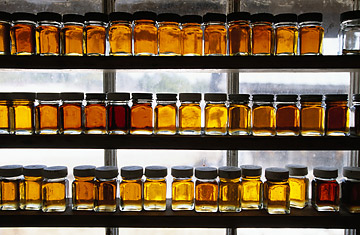
When you think of maple syrup, whose 2009 season is just now wrapping up, the first image that pops into your mind is probably a huge tree trunk with a few metal buckets strapped on. Maybe you picture workhorses slogging through the snow, a sleigh laden with tree sap in tow. Maybe there’s a little wooden shack with a chimney emitting a plume of steam. What you might not picture are the dollar signs many are seeing around this surging agricultural commodity — maple syrup producers are celebrating high yields and record retail prices this year.
For some 300 years, however, sugaring stuck close by that rural idyll. Early settlers in the U.S. Northeast and Canada learned about sugar maples from Native Americans. Various legends exist to explain the initial discovery. One is that the chief of a tribe threw a tomahawk at a tree, sap ran out and his wife boiled venison in the liquid. Another version holds that Native Americans stumbled on sap running from a broken maple branch.
From the 17th century onward, dairy farmers who wanted to supplement their income from milk — or who just needed a source of sweetener that was better and cheaper than sugar or molasses — drilled small holes in the trees during the brief weather window between winter and spring. (Sap typically runs out of maple trees on days when the temperature is around 40 degrees following a night when the mercury dropped below freezing.) The farmers called the maple tree stands “sugar bushes” and hung buckets under the drilled holes. Every day or two — depending on how fast the sap was running out of the trees — the farmers would empty out the buckets into larger containers or tanks and haul the watery substance to a “sugar house” usually built in the woods. Here’s where the magic happened.
It takes about 40 gallons of sap to make one gallon of maple syrup because sap is about 98% water. Sugar makers boiled off most of the water over a wood fire — what they were left with was brown sweet syrup. Some sugar makers heated the sap further, turning it into crystallized sugar. Over time, the industry evolved enough that companies from Quebec to Vermont produced ready-made “evaporators,” essentially giant frying pans with fire boxes built underneath.
As quaint as this image is and as marketable — check out the old-timey drawings on the sides of plastic maple syrup jugs — this is not the face of modern maple syrup making.
These days, most serious sugar makers have foregone labor-intensive buckets, in favor of tubing systems. The holes bored in sugar maples in early spring are usually made with a cordless drill. Sugar makers insert small plastic spouts into the holes and connect the spouts to huge webs of plastic tubing that route the precious sap into large tanks. Many of these sugar bushes even have vacuum systems that suck the sap out of the trees to increase yield, along with oil-fueled furnaces and reverse osmosis filters that remove some water prior to boiling. The technology has changed dramatically, but in essence the process is virtually the same. Collect sap, reduce over heat.
As the natural foods movement has picked up steam in recent years, maple syrup has become, along with honey, an increasingly attractive alternative to processed cane sugar. If you’re wondering where Aunt Jemima or Log Cabin syrup fit into this picture — these common table products are not real maple syrup. The tagline for Log Cabin, which is made with sugar, is “Authentic Maple Tasting Syrup for over 120 years.” This careful wording is intentional and crafted to avoid false advertising claims. (Most brands of maple-flavored pancake toppings are made with corn syrup.)
The actual maple syrup industry has grown some 10% in each of the past four years — and no, maple syrup it not just for flapjacks. These days, some maple syrup devotees use the liquid sweetener as a substitute for sugar in everything from cakes to stir fry. And let’s not forget the Master Cleanse diet — more accurately a fast — in which people eat nothing for days on end, subsisting only on a drink made of water, lemon juice, cayenne pepper and maple syrup.
Thanks to increasing demand and poor sugaring weather in some regions over the past several years, retail prices have spiked to as much as $80 per gallon in some places. In the current sagging economy, that definitely counts as a sweet spot.
More Must-Reads from TIME
- Why Biden Dropped Out
- Ukraine’s Plan to Survive Trump
- The Rise of a New Kind of Parenting Guru
- The Chaos and Commotion of the RNC in Photos
- Why We All Have a Stake in Twisters’ Success
- 8 Eating Habits That Actually Improve Your Sleep
- Welcome to the Noah Lyles Olympics
- Get Our Paris Olympics Newsletter in Your Inbox
Contact us at letters@time.com